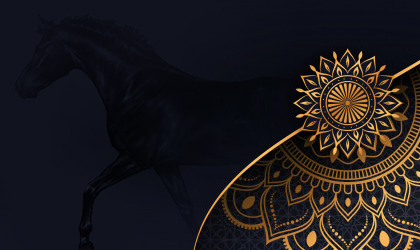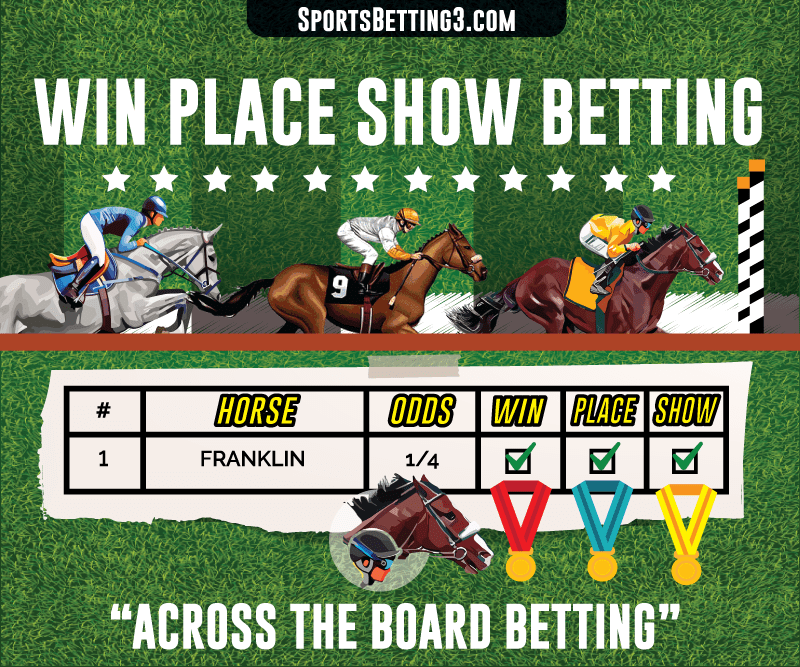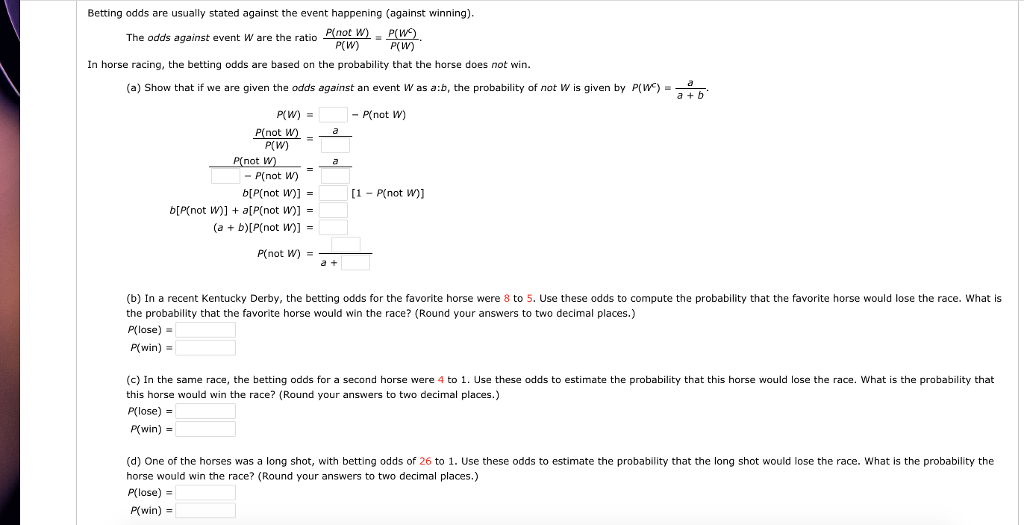Horse Betting Odds Win Place Show
Odds are simply the way prices and payouts are shown at a horse track. The numbers displayed as 4-7 or 2-5 tell you what you pay and how much you get back if the horse you bet on wins. The first number tells you how much you could win, the second number is the amount you bet. So, if the odds are listed as 2-1, you’ll get $2 for every $1 you bet. The place terms for your bet include, the number of places the bookmaker will pay out on, and the fraction of the odds you will get if the horse does place. Usually 1/4 or 1/5. In each-way betting, if your horse wins, you will win both the ‘win’ and ‘place’ parts of your bet.

Betting on a horse race for the first time — even the first few times — can be an intimidating endeavor. What are all of these options? Here’s all the lingo you need to know before you place your first bet:
The Basics
Winbet – A bet on a horse to finish first.
Place bet – A bet on a horse to finish first or second.
Show bet – A bet on a horse to finish in the money; third or better.
In the money – A horse that finishes first, second, or third.

Across the board – A bet on a horse to win, place, and show. If the horse wins, the bettor collects three ways; if second, two ways (place, show); and if third, one way, losing the win and place bets. It’s actually three bets.
Morning line – The odds that the track handicapper predicts a horse will go off at.

Ready for the Next Step?
Exotic (bet) – Any bet other than win, place, or show that requires multiple combinations. Examples of exotic wagers are exacta, trifecta, Pick 6, Pick 4.
Daily Double (or Double) – Type of bet calling for the selection of winners of two consecutive races.
Exacta – A wager in which the first two finishers in a race, in exact order of finish, must be picked.
Box – A betting term denoting a combination bet whereby all possible numeric combinations are covered for certain horses.
Exacta box – A wager in which all possible combinations using a given number of horses are selected. For example, an exacta box using horses 2,4,6 would produce a winning ticket if any two of those three horses finished first and second, regardless of the order (2-6, 4-2, 6-4, etc.).
Trifecta – A bet in which the first three finishers must be selected in exact order.
Trifecta box – A trifecta wager in which all possible combinations using a given number of horses are bet upon.
Pick (6 or other number) – A type of multi-race bet in which the winners of all the included races must be selected. Pick 3, Pick 4, Pick 5, Pick 6 are commonly used by tracks in the United States.
Brush Up on Gambling Lingo

Bounce – A racehorse’s especially poor performance on the heels of an especially good one.
Chalk – Betting favorite in a race.
Chalk player – Gambler who wagers on favorites.
Key horse – A single horse used in multiple combinations in an exotic bet.
On the board – Finishing among the first three.
On the nose – Betting a horse to win only.
Overlay – A horse whose odds are greater than its potential to win. Professional bettors target overlays, meaning they target bets that offer better than fair value odds.
Horse Betting Odds Win Place Show Winners
Underlay – A horse whose odds are less than than his potential to win. Betting horses whose odds are worse than fair value is a poor strategy.
Parlay – A multi-race bet in which all winnings are subsequently wagered on a succeeding race.
Speed Figure – A metric that rates a horse’s performance in a race, which is determined by a combination of the horse’s performance and the level of competition he/she competed against.
Wheel – Betting all possible combinations in an exotic wager using at least one horse as the key.
Win, Place, Show – How To Bet On Horses
WIN (W) bets require that a horse finishes in 1st place.
PLACE (P) bets require that a horse finishes in 1st or 2nd place.
Horse Betting Odds Win Place Shower
SHOW (S) bets require that a horse finishes in 1st, 2nd, or 3rd place.
I’m going to use the diagram (of the finish of a race) below to answer some common questions on the Win, Place, Show bets. The Tote-Board Win odds are above each horse in parenthesis.
Win Place Show Betting System
How do you calculate the expected payout for a Win Bet?
- Win payouts are based on a $2 wager. Multiply the Tote-Board odds times $2 and then add the $2 wager back.
For example, #8 is (7-1), so 7 x $2 = $14, Add $2 = $16 payout.
- To calculate prices for odds other than X-1, simply convert the (fractional) odds to a decimal equivalent and do the same calculation.
For example, odds of (8-5) equals 1.6 x $2 = $3.20, Add $2 = $5.20 payout.
- I always do this mental conversion to decimal equivalents for clarity in my own mind. In fact when I jot down the Tote-Board odds on my sheet they are always in decimal format. For Example:
| Tote-Board | Decimal | Payout |
|---|---|---|
| (9-2) | 4.5 | $11.00 |
| (7-2) | 3.5 | $9.00 |
| (5-2) | 2.5 | $7.00 |
| (9-5) | 1.8 | $5.60 |
| (7-5) | 1.4 | $4.80 |
| (4-5) | 0.8 | $3.60 |
What does it mean to bet a horse “Across the Board?”
This is just a shorthand way for making a Win, Place, and Show bet in equal amounts. For example, if you bet #8 for $2 Across the Board in the above race, your bets would be $2 to Win, $2 to Place, and $2 to Show for a total of $6 wagered.
In this example, a $2 WPS wager on #8 returned $28 ($16w + $7p + $5s).
To continue with the example, the same $2 WPS bet on #6 would have cost $6, but only returned $3 since the Show ticket is the only one cashed.

What happens if I bet a horse to Place and he wins the race?
You get the Place price only. So $2 to Place on #8 returns $7.
Can you calculate the expected Place price based upon the Win odds?
Win, Place, and Show wagers are all placed into separate Pools. So the anticipated Place price cannot be directly calculated based on the Win odds. In addition to that, the Place price is dependent on exactly who the 1st and 2nd place finishers are in the race. For further explanation on this point, keep reading.
Let’s change the order of finish slightly by switching the top two horses #8 and #2.
The former payouts are shown on the left for comparison, and the new payouts are shown on the right.
Since #2 is now the winner, his payout line is switched to the top of the chart. He pays $12 for a win ticket because his odds are 5-1. Formula (5 x $2) + $2.
Notice that the #8 place price stayed exactly the same ($7), as did the #2 place price ($6). That is because the same two horses finished in the top two positions, just in reverse order.
Now let’s change the order of finish again by pushing the #8 horse back to 3rd place and moving the #6 horse up to 2nd place.
Since #2 remains the winner, his Win price ($12) does not change. However, notice that his place price decreased from $6 to $5. Why? Because more total money was bet on #6 (the new 2nd place horse) to place than on #8 (the former 2nd place horse). This is reasonable, considering that the Win odds on #6 are 3-1, while the Win odds on #8 are 7-1.
Generally the amount of money bet on a horse is proportionate between the Win, Place, and Show pools. The simple reason why the payout is less for Place and Show wagers (compared to Win) is that the payout pool is being divided by two horses for Place and three horses for Show.
You can conclude from this information that your best return from a Place or Show wager generally happens when the favorite(s) does not finish “In The Money” (The Top Three Spots). Unless of course you bet on the favorite, which is another story!
There are a lot of opinions on whether or not it’s even wise to make Place and Show bets, as opposed to just Win bets, but we’ll save that topic for a future article.
Select “Get Started” from the menu above for a complete list of articles about Handicapping and Wagering. For example, Racing 101 has several articles about the basics of Horse Racing. And Meet The People has interviews with trainers (e.g. Christophe Clement), Jockeys (e.g. Gary Stevens), and on-track personnel (e.g. Maggie Wolfendale).
By Neal Benoit